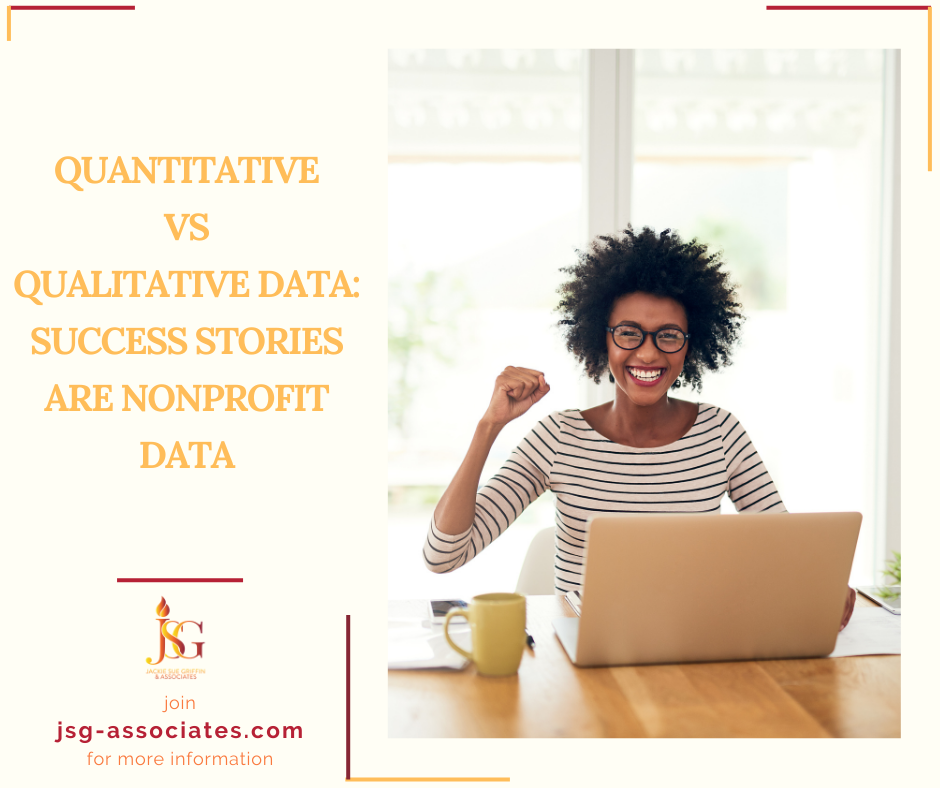
24 Jan Quantitative vs Qualitative Data: Success Stories ARE Nonprofit Data
By Jackie Sue Griffin
In nonprofit work, data is traditionally viewed as tangible metrics, offering a measurable lens through which organizations can gauge their impact. From the number of individuals reached to the funds raised, the emphasis has always leaned heavily on quantifiable outcomes. However, there’s a growing realization that success stories, often viewed as anecdotal, play an equally pivotal role in measuring a nonprofits impact.
The Spectrum of Quantitative Data
Quantitative data is a vital component in tracking a nonprofits success and ensuring that resources are allocated properly. From the number of patients seen, to the hours of counseling provided, these figures offer a measurable snapshot of an organization’s activities and are a vital component of grant applications and ensuring that a nonprofit continues to gain funding. For nonprofit leaders it’s easy to focus solely on these numbers to quantify success – especially with the technology to download complex sets of data in seconds.
Unveiling the Power of Success Stories
While quantitative data holds undeniable merit, success stories are emerging as a compelling counterpart in the nonprofit narrative. These stories of personal experiences and community transformations provide a depth of emotional investment that goes beyond statistics. Success stories capture the essence of impact, offering a nuanced perspective on how nonprofit initiatives affect individual lives. The power of storytelling lies in its ability to humanize data and connect with the emotions and values of both supporters and beneficiaries. As nonprofits navigate the balance between numbers and narratives, success stories are necessary for conveying the depth and resonance of a nonprofits work and ultimate mission. For example, when including Community Needs Assessment data, a way to truly convey your message is to incorporate feedback from the individuals and families you will serve.
Harmony in Integration
A successful nonprofit must rely on a balanced integration of quantitative and qualitative data. A mix of hard numbers and impactful stories creates a comprehensive narrative that resonates with a diverse audience, and with donors. For instance, a behavioral health center may list the number of individual patients they serve, illustrating efficiency and scale. Simultaneously, sharing personal accounts of the families positively impacted by those meals adds an emotional layer, fostering a deeper connection with supporters. Nonprofits adept at harmonizing these data types build a more robust case for their endeavors, effectively communicating the breadth and depth of their impact.
Navigating the Data Landscape
As nonprofits collect data, it’s crucial to acknowledge that both quantitative and qualitative information have distinct roles. Quantitative data excels in providing benchmarks, measuring efficiency, and demonstrating scale. It’s the language of accountability, answering questions about the “what” and “how much.” On the other hand, qualitative data delves into the “why” and “how” by offering narratives, stories, and testimonials. When leveraged collectively, these data types create an alignment between logic and emotions that strengthen the organization’s overall narrative, furthering its ability to attract funding, engage stakeholders, and, most importantly, make a lasting impact on the communities it serves.
Strategic Partnerships
In the realm of nonprofit endeavors, forging strategic partnerships is often a key objective. Quantitative data becomes a powerful ally in these pursuits, but it’s equally crucial to recognize the impact of qualitative data, particularly in the form of compelling success stories. When presenting vivid narratives about the organization’s reach, efficiency, and transformative impact, nonprofits enhance their appeal to potential partners. Whether seeking collaborations with other nonprofits, businesses, or government agencies, the ability to share impactful stories alongside concrete numbers adds a layer of authenticity and emotional connection. It fosters a sense of trust, showcasing the organization as not only data-driven but also driven by powerful human stories.
In tandem, these data sources empower nonprofit leaders to navigate challenges, capitalize on opportunities, and steer their organizations toward long-term success.
Click here to learn more about how JSG & Associates can help your nonprofit.

No Comments